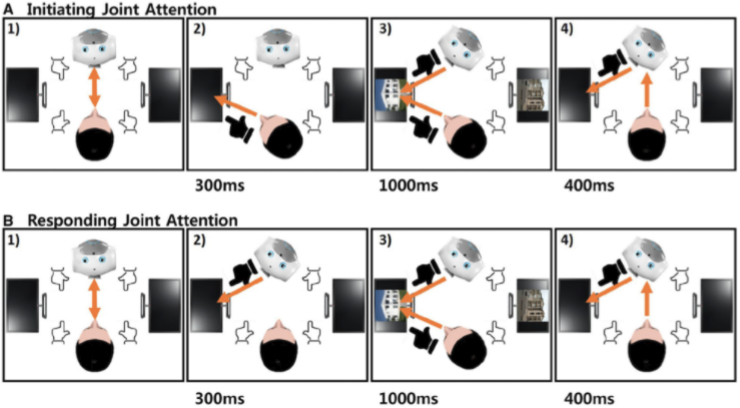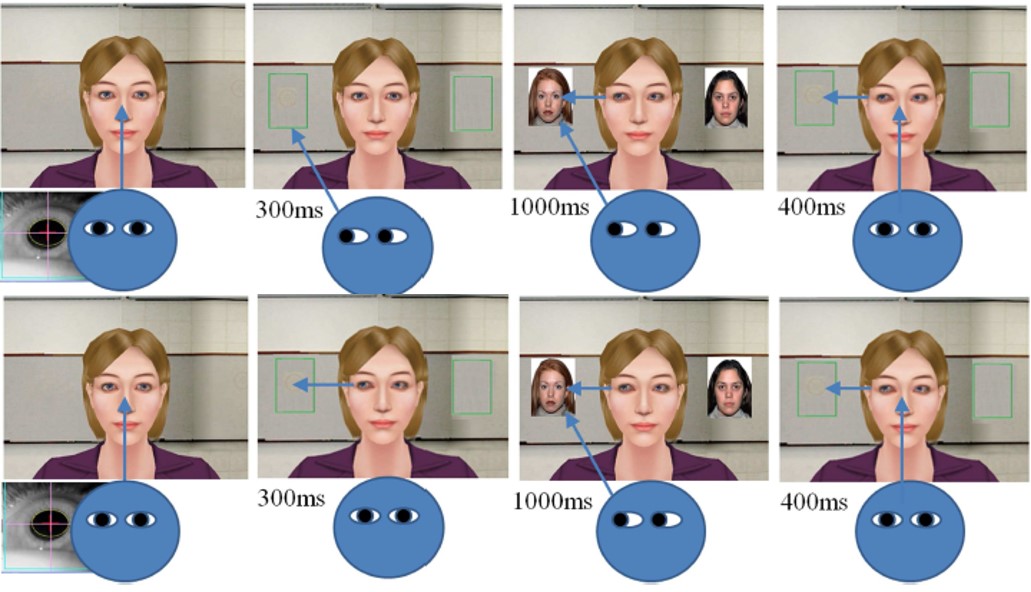
- Research on Human-Robot Interaction
Recent studies on human-robot interations have suggested that humanoid robots have considerable potential in social cognition research. In the current study, we considered two types of social interaction tasks (initiating and responding joint attention tasks) and two types of interaction partners (robot and human partners). The results of study suggested that participants who interacted with a humanoid robot achieved a better recognition memory performance in the initiating JA condition than in the responding JA condition.
We believe this work is important foundation for the utility of humanoid robots in social cognition studies and guture research questions on human-robot interactions.
- Joint attention, social-cognition, and recognition memory in adults
The early emerging capacity for Joint Attention (JA), or socially coordinated visual atten-tion, is thought to be integral to the development of social-cognition in childhood. Recent studies have also begun to suggest that JA affects adult cognition as well, but method-ological limitations hamper research on this topic. To address this issue we developed a novel virtual reality paradigm that integrates eye-tracking and virtual avatar technology to measure two types of JA in adults, Initiating Joint Attention (IJA) and Responding to Joint Attention (RJA). Distinguishing these types of JA in research is important because they are thought to reflect unique, as well as common constellations of processes involved in human social-cognition and social learning.We tested the validity of the differentiation of IJA and RJA in our paradigm in two studies of picture recognition memory in undergrad-uate students. Study 1 indicated that young adults correctly identified more pictures they had previously viewed in an IJA condition (67%) than in a RJA (58%) condition, 2 !D0.57. Study 2 controlled for IJA and RJA stimulus viewing time differences, and replicated the findings of Study 1. The implications of these results for the validity of the paradigm and research on the affects of JA on adult social-cognition are discussed.

- Effect of Human-Computer Interaction Platforms (e.g., virtual reality platform) on Human’s Cognition, Emotion and Behavior
The goal of this project is to investigate the effects of different human-computer interaction platforms (i.e., virtual environment technologies: desktop, head mounted display, or fully immersive platforms) on human’s cognition, emotion, and behavior. One of previous study compared emotional arousal and task performance in the different platforms. Reactivity to stressful VEs was examined in three VE systems from desk-top to high-end fully immersive systems. The experiment was a 3 (desktop system, head mounted display, and six wall system) × 2 (high- and low-stressful VE) within subject design, with self-reported emotional arousal and valence, skin conductance, task performance, presence, and simulator sickness examined as dependent variables. Replicating previous studies, the fully immersive system induced the highest sense of presence and the head mounted display system elicited the highest amount of simulator sickness. Extending previous studies, the results demonstrated that VE platforms were associated with different patterns in emotional responses and task performance. Our findings suggest that different VE systems may be appropriate for different scientific purposes when studying stress reactivity using emotionally evocative tasks.

-
Human-Computer Interaction (HCI) Technology for People with Autism Spectrum Disorders
Impairments in social attention play a major role in autism, but little is known about their role in development after preschool. In this project, a human-computer interaction technology (e.g., public speaking task) was used to study social attention, its moderators, and its association with classroom learning in elementary and secondary students with higher functioning autism spectrum disorder (HFASD). This paradigm assessed the ability to attend to nine avatar peers seated at a table, while simultaneously answering self-referenced questions. Students with HFASD looked less frequently to avatar peers in the classroom while talking. However, social attention was moderated in the HFASD sample such that students with lower IQ, and/or more symptoms of social anxiety, and/or more attention deficit/hyperactivity disorder inattentive symptoms, displayed more atypical social attention. Group differences were more pronounced when the classroom contained social avatars versus nonsocial targets. Moreover, measures of social attention rather than nonsocial attention were significantly associated with parent report and objective measures of learning in the classroom. More research of this kind would likely contribute to advances in the understanding of the development of the spectrum of autism and educational intervention approaches for affected school-aged children.

-
Computer-based Behavioral Measure for People with Obsessive-Compulsive Disorder
Easy to administer behavioral measures are needed to improve the assessment of this hallmark feature of psychiatry disorder. We recently developed a new computer-based behavioral assessment of obsessive-compulsive disorder (OCD) in a previous study. As a follow-up experiment for this method, the goal of this project was to examine whether the new computer-based behavioral assessment would be capable of differentiating behaviors in adults with OCD characterized by checking behavior from those without checking behavior. Here is the result of current study. Despite similar levels of successfully completed tasks, OCD checkers demonstrated longer duration of checking behaviors than OCD controls or HCs. Interestingly, no differences were found between OCD controls and HCs in any of the dependent variables. Our new behavioral measure offers a novel, objective, and ecologically valid measure of checking behaviors in a sample of adults with OCD.

